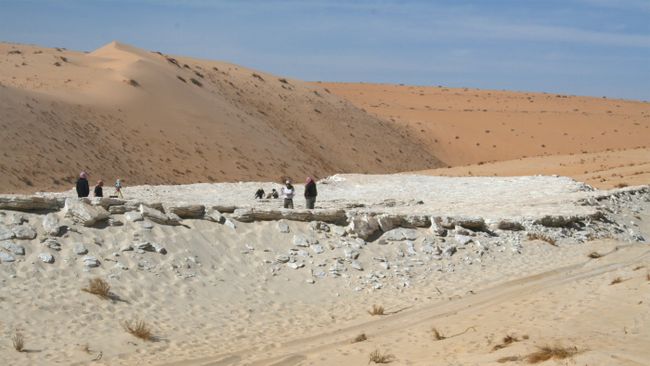Prehistoric desert footprints are earliest evidence for humans on Arabian Peninsula
By Richard Clark-Wilson - PhD Candidate in Geography, Royal Holloway 16 hours ago

Researchers surveying the Alathar lake, situated within an interdunal depression in the western
Nefud Desert, Saudi Arabia. (Image: © Palaeodeserts Project)
Humanity originated on the African continent at least 300,000 years ago. We know from fossil evidence in southern Greece and the Levant (modern-day Israel) that some early members of our species expanded beyond Africa around 200,000 years ago, and again between 120,000 to 90,000 years ago. They likely travelled through the Sinai peninsula, which formed the only land bridge connecting the continent of Africa to the rest of the world, before moving north into a landscape with a Mediterranean climate.
But it was not known at what point humans turned south after crossing the Sinai peninsula, reaching modern day Saudi Arabia. It is also often assumed that they may have taken a coastal route, avoiding the currently harsh desert interior. Previous fossil finds show this was not the case, with humans moving into the heart of Arabia at least 85,000 years ago. Now, new research pushes this date back even further.
Colleagues and I discovered human and other animal footprints embedded on an ancient lake surface in the Nefud Desert in Saudi Arabia that are around 120,000 years old. These findings represent the earliest evidence for Homo sapiens on the Arabian Peninsula, and demonstrates the importance of Arabia for understanding human prehistory.
The Nefud Desert in modern-day Saudi Arabia lies around 500km to the southeast of the Sinai Peninsula. Today, the Arabian deserts are some of the most inhospitable environments in the world. They would form an impassable barrier for prehistoric humans or large mammals. Imagine standing at the foot of a hyper-arid desert equipped with stone tools.
More:
https://www.livescience.com/earliest-evidence-for-humans-on-arabian-peninsula-146445.html
